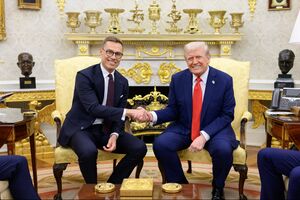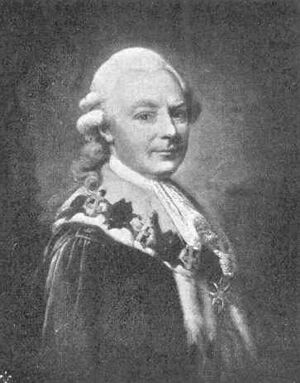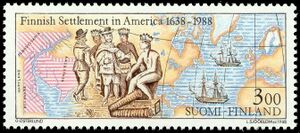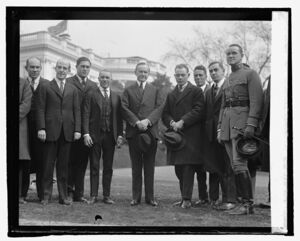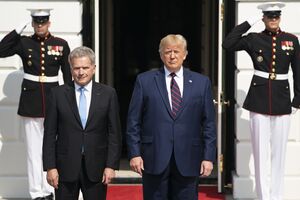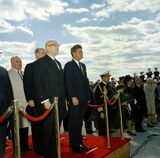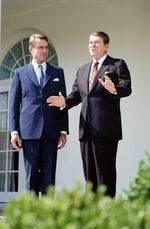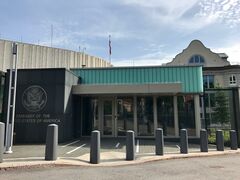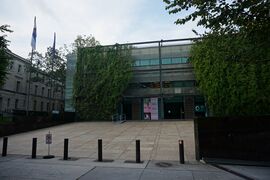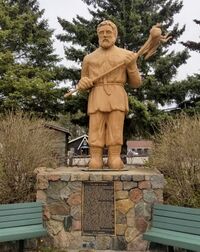العلاقات الأمريكية الفنلندية
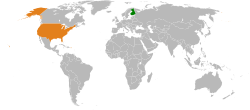 | |
فنلندا |
الولايات المتحدة |
|---|---|
| البعثات الدبلوماسية | |
| Embassy of Finland, Washington, D.C. | Embassy of the United States, Helsinki |
Finland and the United States currently have good relations. The United States recognized Finland on May 7, 1919 after it declared independence in 1917, and officially established diplomatic relations in 1920. Due to World War II and Soviet pressure, relations were suspended between 1942 and 1945 before being raised to embassy level in 1954. Finland has been of strategic importance to the United States due to its position bordering the Soviet Union and later Russia, and after the end of the Cold War in 1991 Finland's shift to the West has led to warmer relations. There is significant trade activity, including military procurement, between the two countries.
The United States supported Finland's NATO membership during Finland's accession into NATO, which was finalized on 4 April 2023, and later that year, the two countries entered into a Defense Cooperation Agreement. Currently, both countries are members of NATO and the Arctic Council. The United States is an observer of the BEAC and CBSS while Finland is a member of them.
The United States constitutes Finland’s principal trading partner, reflecting a high level of bilateral economic integration. Finnish exports to the United States predominantly comprise transport equipment, chemical products, paper goods, and machinery, underscoring Finland’s advanced capabilities in the maritime, energy, transport, and bioeconomy sectors. Beyond commercial exchange, Finland and the United States have deepened their collaborative engagement in science and technology, with notable emphasis on quantum computing, high‑performance computing, advanced communication networks, and other emergent transformative technologies.[1]
At the subnational level, Finland maintains formal cooperation agreements with the states of Colorado, Maine, Michigan, Minnesota, Texas, and Washington. These arrangements are designed to facilitate market entry for Finnish enterprises and research institutions into individual state economies, while equally enabling American companies to access commercial opportunities in Finland.[1]
التاريخ
مملكة السويد 1100-1809
The connection between Finns and the United States dates back to the American War of Independence. At that time, Finland was part of the Kingdom of Sweden, which was allied with France. France supported the American cause during the war, and Sweden provided political backing as well as volunteers. Finnish officers Georg Magnus Sprengtporten and Gustaf Mauritz Armfelt were eager to take part in the conflict, but they were denied permission to leave. Sprengtporten, however, drew inspiration from the American struggle, which influenced his later vision of an independent Finnish republic.[2]
The Finnish-born Count Gustaf Philip Creutz served as Sweden’s ambassador in Paris during the era of King Gustav III of Sweden. In that capacity, Creutz and Benjamin Franklin signed the Treaty of Amity and Commerce between Sweden and the United States.[2]
In 1776, an important Signer of the United States Declaration of Independence, John Morton, was the descendant of early Finnish pioneers who had founded New Sweden colony on the Delaware in 1638. Ethnic Finns, including “Forest Finns” who had been temporarily resettled to use slash-and-burn agriculture to clear parts of Sweden proper like Värmland, would account for the majority of permanent settlers who moved on to America: Finnish trailblazers transplanted log cabin architecture from Tavastia, Savo and Karelia, which would become icons of American frontier culture in the Thirteen Colonies and early United States, such as the Nothnagle Log House.[3][4] The University of Turku hosts the John Morton Center for North American Studies.[5][6]
دوقية فنلندا الكبرى 1809-1917
During the Napoleonic Wars, Sweden refused to join the Continental System, meaning it did not agree to be subjected to a British trade embargo, as the United Kingdom was Sweden’s most important trading partner.[2]
In 1808, France under Emperor Napoleon and Russia under Emperor Alexander I were allies. France and Russia launched a two-front war against Sweden. During the Finnish War, Sweden lost Finland.[2]
In 1809, Russia transformed Finland into an autonomous Grand Duchy without an independent foreign policy. Finland's trade with the United States was negligible, as its main trading partners were Russia, Germany, and the United Kingdom.[2]
In 1867, Emperor Alexander II of Russia, also Grand Duke of Finland, sold Alaska to the United States.[2]
The first Finns had emigrated to North America as early as the 1630s. In the late 19th century, 300,000 Finns moved to the United States, settling in the Midwest and Northwest regions. These new immigrants created a permanent link between Finland and the United States.[7]
During the First World War, Russia, France, and the United Kingdom were allies. In the midst of the war, the February Revolution of 1917 forced Tsar Nicholas II to abdicate the throne, leading to the establishment of a bourgeois Russian Republic. Later that year, the communist October Revolution took place in Russia, resulting in the creation of Soviet Russia. Finland declared independence in December 1917. A project to establish a Finnish monarchy was initiated but failed in 1918, and in 1919 Finland became a republic.[2]
فنلندا 1917-

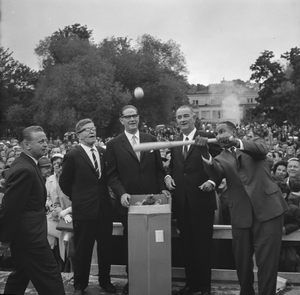

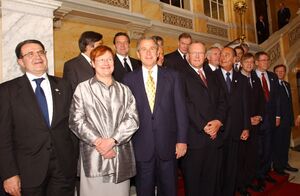
Finland declared its independence from Russia on December 6, 1917, amid the upheavals of World War I and the Russian Revolutions. Shortly after the declaration, Finland plunged into a civil war between the White forces (supporting a conservative, non-socialist government) and the Red forces (socialists backed by Bolshevik Russia), which lasted from January to April 1918. The White forces ultimately prevailed with German support. The country also faced a severe famine during this period.[8]
The famine was alleviated through international aid, notably from American organizations including the American Red Cross, the American Relief Administration, and the European Children's Fund. The key Finnish contact in London during this relief effort was Rudolf Holsti, who later served as Finland's Foreign Minister from 1919 to 1922 and again from 1936 to 1938. Herbert Hoover, then head of the American Relief Administration, was instrumental in coordinating these humanitarian supplies.[8][2]
Holsti expressed profound gratitude for the aid and recognition by the international community, stating that "the entire Finnish nation will never forget the moral greatness of the decision of the associated governments in recognizing the Independence of Finland."[8]
This period marked a foundational moment for Finland as a newly independent nation, recovering from war, famine, and political turmoil with significant assistance from the United States and its allies.[8]
The U.S. recognized Finland soon after its independence in 1919.[9]
The United States established diplomatic relations with Finland on May 27, 1919, when Acting Secretary of State Frank L. Polk recognized Armas Herman Saastamoinen as provisional Envoy Extraordinary and Minister Plenipotentiary of the de facto Government of Finland. At that time, U.S. President Woodrow Wilson was still in Europe attending the Paris Peace Conference. Saastamoinen was formally recognized as Envoy Extraordinary and Minister Plenipotentiary on August 21, 1919, upon President Wilson's return to the United States.[10]
Diplomatic relations between the governments of Finland and the United States were established in 1920 at a legation level. The U.S. Legation in Helsinki was established on March 19, 1920, when Chargé d’Affaires pro tem Alexander R. Magruder presented his credentials to the Finnish government.[9][10]
Finland joined the League of Nations, conceived by U.S. President Woodrow Wilson, in 1920.[2] During the interwar period, relations between Finland and the United States were generally positive and strengthened over time. Finland followed a policy of neutrality and "friendship toward all and alliances with none." President Franklin D. Roosevelt praised Finland for its responsible attitude in repaying food debts to the U.S., and he offered favorable debt repayment terms during the 1930s, although these were ultimately blocked by the U.S. Congress. During the Great Depression of the 1930’s, Finland was the only nation to continue to pay off debts it owed to the United States from World War I.[11][12][10]
Throughout the 1930s, Finland endorsed several U.S. proposals related to disarmament, international peace, and trade liberalization. The U.S. public and government sympathized with Finland, especially during Finland's conflict with the Soviet Union in the Winter War of 1939-1940, demonstrating a shared commitment to democracy and shared values. However, U.S. support was limited due to isolationist tendencies and complexities in Soviet relations.[11][12]
During the Second World War, although the Finnish government co-operated with the Axis Powers, relations were maintained. The U.S. government resisted Soviet pressures to declare war on Finland, but on June 30, 1944, it agreed to sever diplomatic relations with the Finnish government. After Finland had withdrawn from the war and acted against German troops in early 1945, the U.S. government reopened its legation in Helsinki on March 1, 1945. On August 20, 1945, negotiations were started between the two governments on re-establishing diplomatic relations, which was done on August 31.[13]
Juho Kusti Paasikivi, the President of Finland, was interested in participating in a meeting in 1947 that addressed post–Second World War Marshall Aid. Paasikivi was keen on receiving assistance. Finland was forced to abandon its plans due to pressure from the Soviet Union. Instead, Finland succeeded in negotiating favorable loans from the United States.[14]
The United States elevated its legation in Helsinki to the status of an embassy when Jack K. McFall presented his credentials as Ambassador Extraordinary and Plenipotentiary on November 15, 1952. This marked the formal establishment of the U.S. Embassy in Helsinki, reinforcing the diplomatic relationship between the two nations at a higher level of representation following World War II.[10]
During the Cold War, relations between Finland and the United States were characterized by economic, cultural, and scientific cooperation. Finland was among the first countries to be invited to participate in the Fulbright Program, an international educational exchange initiative, in 1947. The ASLA-Fulbright scholarship became an important program aimed at students, postgraduate researchers, and academic research. Finland sent out the first ASLA grantees in 1950. Finland welcomed the first American Fulbright grantees in 1953. The scholarship is financed in part from a trust fund established in 1976 from Finland's final repayment of a U.S. loan made in the aftermath of World War I. Finnish President Urho Kekkonen and U.S. President Gerald Ford Founded the Trust Fund in connection with the Conference on Security and Cooperation in Europe (CSCE) in Helsinki. Senator J. William Fulbright, a great friend of Finland and its people whom he referred to as "the courageous Finns," held this funding arrangement in high regard. During his first visit to Finland, he expressed gratitude to the nation for elevating the prestige of the Fulbright Program through its exemplary cooperation and commitment. American popular culture gained a significant foothold in Finland during the Cold War.[2][15][16]
The United States was a member of the Coordinating Committee for Multilateral Export Controls, whose purpose was to prevent dual-use technology from falling into the possession of the Soviet Union and the Eastern Bloc. Finland was not an official member of the Coordinating Committee for Multilateral Export Controls, but it adhered to its policies because Finland did not want to jeopardize trade and technological exchange with the United States.[2] The United States was well aware of Finland’s delicate geopolitical position during the Cold War and adopted a policy of supporting Finnish independence and Western-oriented engagement without provoking Soviet sensitivities. American initiatives encouraged cultural and academic exchanges, expanded trade relations, and facilitated Finnish participation in international organisations. The United States also endorsed Finland’s gradual alignment with Western economic frameworks. Finland’s accession to the General Agreement on Tariffs and Trade (GATT) in 1950 marked the first step toward international economic cooperation. This was followed by its association with the European Free Trade Association (EFTA) in 1961 and eventual membership in the Organisation for Economic Cooperation and Development (OECD) in 1969, symbolising Finland’s deeper integration into the Western economic sphere.[17]
The relatively low level of political tension in Northern Europe, together with Finland’s policy of actively fostering East–West relations, aligned well with the strategic interests of the United States. During the Cold War, Finland played a notable role as a neutral intermediary and a diplomatic meeting ground between the United States and the Soviet Union. Helsinki, in particular, became a recognized venue for international dialogue, hosting the first Strategic Arms Limitation Talks (SALT I) in the early 1970s.[17]
Throughout the Cold War period, several American presidents and senior officials visited Finland en route to Moscow, underlining the country’s importance as a bridge between the superpowers. Even after the end of the Cold War, Helsinki continued to serve as a symbolic and practical site for diplomatic encounters. Notably, U.S. President George H. W. Bush and Soviet President Mikhail Gorbachev held a summit there in 1990, and President Bill Clinton met Russian President Boris Yeltsin in Helsinki in 1997.[17]
Following the fall of the Berlin Wall and the conclusion of the Cold War, Finland actively supported the reconstruction and reintegration of Europe in pursuit of what President Bill Clinton described as a “Europe whole and free.” Consistent with its strong commitment to institutional cooperation, Finland emphasized the importance of maintaining openness within the democratic organizations of the West, ensuring that all European nations committed to democracy would have the opportunity to join and participate in shared structures. Finland endorsed the enlargement of both the European Union and the North Atlantic Treaty Organization, regarding these processes as essential to promoting the dual objectives of stability and prosperity across the European continent.[17]
Finland’s relations with the United States remained cordial during the presidencies of Paasikivi, Kekkonen, and Mauno Koivisto, who guided Finland’s foreign policy throughout the Cold War. Within the constraints of its political neutrality, Finland strengthened its economic cooperation with the United States. After the end of the Cold War, Finland established official relations with NATO in 1992, purchased McDonnell Douglas F/A-18 Hornet fighter jets from the United States that same year, and decided to apply for membership in the European Union. These developments symbolized Finland’s new position in the post–Cold War world. As a natural outcome, relations between Finland and the United States deepened and broadened further. President Martti Ahtisaari established immediate relations with President Clinton and the White House.[2]
In 2003, Anneli Jäätteenmäki, leader of the Centre Party, won the Finnish parliamentary election. During the campaign, she accused the incumbent Prime Minister, Paavo Lipponen, of aligning neutral Finland with the United States in the Iraq War following a meeting with U.S. President George W. Bush. This accusation was based on confidential foreign ministry documents that suggested Finnish cooperation with the U.S.-led coalition, which many Finns considered an illegal war of aggression. Lipponen denied the claims, affirming Finland's support for the United Nations and its Secretary-General.
Jäätteenmäki's government, formed after the election, lasted only 63 days. She resigned amid allegations that she had misled Parliament regarding the manner in which she obtained the leaked documents. Jäätteenmäki received the documents from President Tarja Halonen’s adviser, Martti Manninen. The scandal, widely referred to in Finland as the "Iraq leak".[18][19]
The aftermath of the scandal is overshadowed by the question of President Tarja Halonen’s role in the matter. There were foreign policy differences between Halonen and Lipponen, whereas Jäätteenmäki represented a stance more closely aligned with Halonen. The uproar was unnecessary, as Finland’s foreign policy is led by the President of Finland in cooperation with the Finnish Government.[20][19]
In 2004, former Finnish diplomat Max Jakobson expressed surprise at what he characterised as President Tarja Halonen’s complete absence of relations with the United States. The remarks form part of Jakobson’s broader commentary on Finland’s foreign policy. President Halonen responded by firmly rejecting the criticism, defending her record and approach to Finland–United States relations. Jakobson’s observations add to ongoing public debate about the priorities and direction of Finnish diplomacy during Halonen’s presidency.[21][22]
On 18 May 2007, President Tarja Halonen affirmed that, in regard to her own country, Finland, it was always gratifying to observe that its relations with the United States were long-standing, extensive, and of an excellent quality. She emphasised that the United States was Finland’s most significant trading and investment partner outside Europe. Areas such as new technology and innovation constituted shared fields of interest. In recent years, cooperation between the United States and Finland had intensified markedly in matters relating to energy. American interest extended not only to Finland’s expertise in nuclear energy, but also to its experience in utilising renewable energy sources, notably the second-generation technological projects then underway in Finland aimed at biofuel production. She further noted that other fields with promising prospects for bilateral collaboration included healthcare, education, and issues concerning northern and Arctic regions.[23][24]
President Sauli Niinistö had a cooperative and constructive relationship with U.S. President Barack Obama during his time in office. A notable encounter occurred at the U.S.-Nordic Leaders Summit in Washington, D.C. on May 13, 2016, where President Obama hosted the leaders of Denmark, Finland, Iceland, Norway, and Sweden at the White House. The summit focused on deepening cooperation between the Nordic countries and the United States in areas including counterterrorism, nuclear security, Arctic affairs, humanitarian assistance, sustainable development, environmental and health issues, European security, trade relations, and migration and the refugee crisis.[25][26]
President Sauli Niinistö maintained regular and pragmatic relations with U.S. President Donald Trump, meeting him multiple times during Trump's administration. Their official bilateral meetings included working visits to Washington, D.C., in August 2017 and October 2019, as well as discussions on the sidelines of multinational summits.[27][28]
Their October 2019 meeting featured bilateral discussions in the Oval Office, followed by a working lunch and a joint press conference. The presidents discussed security, Arctic issues, arms control, and economic and technology cooperation, especially regarding 5G and 6G technologies, artificial intelligence, and robotics. Both leaders mentioned the importance of transatlantic security partnership and climate and environmental challenges in the Arctic.[28]
Niinistö met multiple times with U.S. President Joe Biden, including meetings in Washington D.C. in March 2023 and September 2023, where they discussed Finland's and Sweden's NATO membership, support for Ukraine, broader global developments, and superpower competition. President Biden described Finland as a "strong defensive partner" and an important member of the transatlantic alliance.[29][30]
According to Statistics Finland, as of recent data available in 2025, there were 6,835 American-born people living in Finland. This figure pertains to the foreign-born population residing in Finland.[31]
The number of travelers from the United States to Finland has been steadily increasing, amounting to between 200,000 and 380,000 visitors each year.[32]
In 2019, Finnish Air Force and USSPACECOM signed a Memorandum of Understanding between Finland and the United States on space situational awareness cooperation in Helsinki, Finland. These agreements foster openness, predictability of space operations, and transparency for space domain awareness.
On August 3, 2022, the U.S. Senate unanimously approved Finland and Sweden's accession bids to join NATO.[33] U.S. President Joe Biden approved the NATO membership of Finland and Sweden in August 2022.[34]

On December 18, 2023, the US (represented by Antony Blinken) and Finland (represented by Antti Häkkänen and Elina Valtonen) signed a Defense Cooperation Agreement (DCA) in Washington, D.C.[35][36]
The agreement regulates the presence of the US armed forces and their dependents on the territory of the Finland, as well as the presence and activities of US suppliers on the territory of the Finland.[37]
President Joe Biden visited Helsinki on July 12, 2023 and met with Finnish President Sauli Niinistö and leaders of other Nordic nations, including Sweden, Norway, Denmark and Iceland. The purpose was to celebrate Finland joining the NATO.[38][39][40]
During the second term of US President Donald Trump, Finnish President Alexander Stubb established a good personal rapport with Trump over their shared interest in golf, with the United States committing to purchase icebreakers from Finland in March 2025.[41] To this trust experts attributed the American invitation of the Finnish President to participate in talks at the August 2025 White House Multilateral Meeting on Ukraine, making Finland the only small country represented at the high-stakes summit in Washington alongside the leaders of France, Germany, Italy, the UK, Ukraine, the EU, and NATO.[42][43]
The increasing importance of close relations between Finland and the United States was further evidenced by the announcement that a third meeting between Presidents Stubb and Trump - for the first time accompanied by Finnish Prime Minister Petteri Orpo - was scheduled to take place over a two-day visit by Finnish officials to meet with American officials to discuss a variety of topics at the White House in October 2025.[44]
The United States Ambassador to Finland is Howard Brodie. The current Finnish Ambassador to the United States is Leena-Kaisa Mikkola, who began her posting in September 2024.[45][46]
تجارة
In 2024, the United States' share of Finland's exports was about 9.6% and of imports 5.0%, and the United States was Finland's third largest export country and sixth largest import country.[47]
Finland's exports to the U.S. in 2024 were around $10.1 billion, including chemicals, machinery (except electrical), petroleum and coal products, paper, and electronic products. Meanwhile, U.S. exports to Finland were about $4.5 billion, mainly oil and gas, electronics, chemicals, minerals, and transportation equipment.[48]
زيارات رؤساء الدول
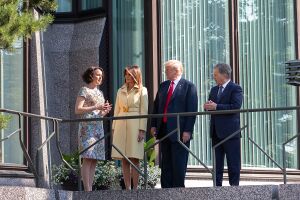
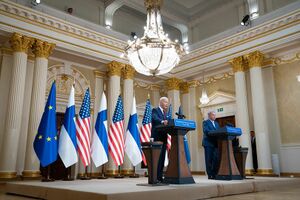

During 1975–2023 six presidents of the United States have visited Finland. Of them, George H. W. Bush visited Finland twice. Basic facts of these visits are given in the table below. In some cases, the table contains only the arrival date.[49]
In addition to this, Barack Obama visited Finland during 26–27 September 2019. He gave a talk at the Nordic Business Forum.[50]
| Visits of United States Presidents to Finland | ||||||||
| No | Year | Date | Visitor | Host | Reason for the visit | |||
|---|---|---|---|---|---|---|---|---|
| 1. | 1975 | 29 July | Gerald Ford | Urho Kekkonen | Attended CSCE Summit | |||
| 2. | 1988 | 26–29 May | Ronald Reagan | Mauno Koivisto | Stop on the way to Moscow to meet with Mikhail Gorbachev | |||
| 3. | 1990 | 8 September | George H. W. Bush | Mauno Koivisto | Meeting with Mikhail Gorbachev in Helsinki | |||
| 4. | 1992 | 8 July | George H. W. Bush | Mauno Koivisto | Attended CSCE Summit | |||
| 5. | 1997 | 20 March | Bill Clinton | Martti Ahtisaari | Meeting with Boris Yeltsin in Helsinki | |||
| 6. | 2018 | 15–16 July | Donald Trump | Sauli Niinistö | Meeting with Vladimir Putin in Helsinki | |||
| 7. | 2023 | 13–14 July | Joe Biden | Sauli Niinistö | Meeting with Niinistö Meeting with Nordic prime ministers | |||
| Visits of Finland Presidents to United States | ||||||||
| No | Year | Date | Visitor | Host | Reason for the visit | |||
|---|---|---|---|---|---|---|---|---|
| 1. | 1961 | 16–18 October | Urho Kekkonen | John F. Kennedy | Meeting with John F. Kennedy | |||
| 2. | 1970 | 23–25 July | Urho Kekkonen | Richard Nixon | Meeting with Richard Nixon | |||
| 3. | 1970 | 24 October | Urho Kekkonen | Richard Nixon | Attended White House dinner on 25th Anniversary of the U.N | |||
| 4. | 1976 | 3–5 August | Urho Kekkonen | Gerald R. Ford | Meeting with Gerald R. Ford | |||
| 5. | 1983 | 24–27 September | Mauno Koivisto | Ronald Reagan | Meeting with Ronald Reagan | |||
| 6. | 1991 | 6–8 May | Mauno Kivisto | George H. W. Bush | Meeting with George H. W. Bush | |||
| 7. | 1994 | 8–10 November | Martti Ahtisaari | Bill Clinton | Meeting with Bill Clinton | |||
| 8. | 1999 | 16–17 December | Martti Ahtisaari | Bill Clinton | Meeting with Bill Clinton | |||
| 9. | 2000 | 28 April | Tarja Halonen | Bill Clinton | Meeting with Bill Clinton | |||
| 10. | 2002 | 16 April | Tarja Halonen | George W. Bush | Meeting with George W. Bush | |||
| 11. | 2016 | 13 May | Sauli Niinistö | Barack Obama | Meeting with Barack Obama Meeting with Nordic prime ministers | |||
| 12. | 2017 | 28 August | Sauli Niinistö | Donald Trump | Meeting with Donald Trump | |||
| 13. | 2019 | 1–3 October | Sauli Niinistö | Donald Trump | Meeting with Donald Trump | |||
| 14. | 2022 | 4 March | Sauli Niinistö | Joe Biden | Meeting with Joe Biden | |||
| 15. | 2022 | 19 May | Sauli Niinistö | Joe Biden | Meeting with Joe Biden Meeting with Swedish prime minister Magdalena Andersson | |||
| 16. | 2023 | 6–10 March | Sauli Niinistö | Joe Biden | Meeting with Joe Biden | |||
| 17. | 2024 | 9–11 July | Alexander Stubb | Joe Biden | Meeting with Joe Biden attend 2024 NATO summit | |||
| 18. | 2025 | 29 March | Alexander Stubb | Donald Trump | Meeting with Donald Trump in Mar-a-Lago | |||
| 19. | 2025 | 18 August | Alexander Stubb | Donald Trump | Meeting with Donald Trump and European leaders at the White House | |||
| 20. | 2025 | 9–10 October | Alexander Stubb Petteri Orpo |
Donald Trump | Meeting with Donald Trump and other top U.S. officials at the White House[44] | |||
معرض الصور
Finnish Congregational Church and Parsonage in South Thomaston, Maine, United States
Finland and USA are very at the same level in ice hockey and the matches between the two have always been entertaining
Finland, Minnesota is a village founded by immigrants of Finnish origin
Finnish Air Force Hawker Hurricane warbird with US Navy T-6 Texan warbird in Finland
السفارات
The Embassy of the United States is located in Helsinki. The Embassy of Finland is located in Washington, D.C.
الرأي العام
According to the Meridian International Center and Gallup's U.S.-Global Leadership Project, as of 2012, 48% of Finnish people approved of U.S. leadership, with 34% disapproving and 18% uncertain.[51]
العلاقات القطبية الشمالية
Finland–United States relations on Arctic issues are strong. Addressing these issues is normally done through the Arctic Council, as both countries believe it to be the leading way of cooperation on Arctic issues.
At the 2024 NATO summit, on 11 July 2024, it was decided that the United States, Canada and Finland are to form the ICE Pact, in which Finland will serve as the majority builder of icebreaker vessels.[52][53]
In October 2025, Alexander Stubb and Donald Trump sign a memorandum of understanding about "icebreaker cooperation".[54][55]
التبادل الثقافي
The League of Finnish-American Societies (فنلندية: Suomi-Amerikka Yhdistysten Liitto) is a non-profit organization promoting cultural exchange between countries which operates in Finland. It has around 30 chapters in Finland, e.g. those in Helsinki, Turku, Oulu and Kuopio.[56]
Finnish Americans celebrate FinnFest USA, a festival held annually in the United States on the occasion of midsummer.[57]
انظر أيضا
- Foreign relations of Finland
- Foreign relations of the United States
- US–EU relations
- NATO-EU relations
- Agreement on Defense Cooperation between Finland and the United States of America
- Finnish Americans
المصادر
- ^ أ ب "Suomen ja Yhdysvaltain suhteet". Suomi ulkomailla: Yhdysvallat (in الفنلندية). Retrieved 2025-10-09.
- ^ أ ب ت ث ج ح خ د ذ ر ز س Aminoff, Jukka (2021). Suomen Ruotsi ja Venäjä: Suomi muuttuvien maailmanjärjestysten keskellä. Helsinki: Readme.fi. ISBN 978-952-373-254-4.
- ^ Niitemaa, Vilho; Saukkonen, Jussi; Aaltio, Tauri; Koivukangas, Olavi, eds. (1976). Old Friends — Strong Ties [Finland salutes U.S.A.] (PDF). Turku, Finland: Institute for migration. ISBN 9789519266084. LCCN 77374164. OCLC 3606828. Archived from the original (PDF) on 22 December 2024.
- ^ Jordan, Terry G.; Kaups, Matti E. (1989). The American Backwoods Frontier: An Ethnic and Ecological Interpretation. Baltimore: Johns Hopkins University Press. ISBN 978-0801836862. OCLC 17804299.
- ^ "Suhteiden historia". Suomi ulkomailla: Yhdysvallat (in الفنلندية). Retrieved 2025-10-09.
- ^ "The John Morton Center for North American Studies | University of Turku". www.utu.fi (in الإنجليزية). Retrieved 2025-10-09.
- ^ "The history of our relations". Finland abroad: United States of America (in الإنجليزية الأمريكية). Retrieved 2025-10-09.
- ^ أ ب ت ث "Herbert Hoover's Travels To Finland". Hoover Institution (in الإنجليزية). Retrieved 2025-10-09.
- ^ أ ب K. Marianne Wargelin Brown, "Finnish Americans." Gale Encyclopedia of Multicultural America, edited by Thomas Riggs, (3rd ed., vol. 2, Gale, 2014), pp. 137-151.
- ^ أ ب ت ث "Finland - Countries - Office of the Historian". history.state.gov. Retrieved 2025-10-09.
- ^ أ ب "Centennial Story of Finland Part 3: Interwar Instability 1927–1937". Finland abroad: United States of America (in الإنجليزية الأمريكية). Retrieved 2025-10-09.
- ^ أ ب "The Country That Paid Its Debts Exhibition 2004". Fulbright Finland Foundation (in الإنجليزية). Retrieved 2025-10-09.
- ^ Department of State Bulletin, September 2, 1945, p. 339
- ^ Polvinen, Tuomo; Immonen, Hannu; Polvinen, Tuomo (2020). Hirmuisten vuosien valtiomies: J.K. Paasikivi 1870-1956. Historian aitta. Paasikivi-seura. Helsinki: Minerva Kustannus Oy. ISBN 978-952-375-287-0.
- ^ Fields, Marek; Fields, Marek (2019). Lännestä tuulee: Britannian ja Yhdysvaltojen propaganda kylmän sodan Suomessa. Helsinki: Art House. ISBN 978-951-884-714-7.
- ^ "History Unlike Any Other". Fulbright Finland Foundation (in الإنجليزية). Retrieved 2025-10-09.
- ^ أ ب ت ث "Pertti Torstila, Secretary of State, on Finland-USA - 90 years of diplomatic relations -USA - 90 years of diplomatic relations". Ministry for Foreign Affairs (in الإنجليزية الأمريكية). Retrieved 2025-10-09.
- ^ "Former Finnish premier is cleared over Iraq papers leak". The Independent. 20 March 2004.
- ^ أ ب "Salattu ja unohdettu muistio paljastaa: Tarja Halonen lähetti kiitokset, ettei Anneli Jäätteenmäki kytkenyt häntä Irak-skandaaliin". Ilta-Sanomat (in الفنلندية). 2023-03-08. Retrieved 2025-10-10.
- ^ "Kommentti: Irak-gate tarvitsisi jo loppupisteen – yksi kysymys jää edelleen avoimeksi ja siksi Tarja Halonen saisi tehdä muistelmat". Ilta-Sanomat (in الفنلندية). 2023-03-08. Retrieved 2025-10-10.
- ^ "Presidentti Halonen: Suomen ja Yhdysvaltojen välit hyvät". mtvuutiset.fi (in الفنلندية). Retrieved 2025-10-09.
- ^ IS (2012-01-19). "Korkea virkamies: Vaikeudet USA-suhteissa alkoivat Halosen kaudella". Ilta-Sanomat (in الفنلندية). Retrieved 2025-10-09.
- ^ "Suomen tasavallan presidentti: Tiedotteet ja uutiset". www.presidentti.fi. Retrieved 2025-10-09.
- ^ STT (2007-05-15). "Halonen: Suhteissa Yhdysvaltoihin ei ongelmia". Ilta-Sanomat (in الفنلندية). Retrieved 2025-10-09.
- ^ "President Niinistö to make official visit to the United States | Tasavallan presidentin kanslia". www.sttinfo.fi (in الفنلندية). Retrieved 2025-10-10.
- ^ "Historic Meeting Between Nordic and U.S. Leaders". Finland abroad: United States of America (in الإنجليزية الأمريكية). Retrieved 2025-10-10.
- ^ "Presidentti Niinistö tapasi presidentti Trumpin Washingtonissa". Suomi ulkomailla: Yhdysvallat (in الفنلندية). Retrieved 2025-10-10.
- ^ أ ب Porre, Matti (2019-10-02). "Presidentti Niinistö Washingtonissa: Eurooppa tarvitsee Yhdysvaltoja, mutta Yhdysvallat tarvitsee myös Eurooppaa". Tasavallan presidentti Sauli Niinistö (in الفنلندية). Retrieved 2025-10-10.
- ^ "Niinistö on White House visit: "Well, we don't usually start wars"". News (in الإنجليزية). 2022-03-04. Retrieved 2025-10-10.
- ^ Pekkarinen, Virpi (2023-03-10). "President Niinistö in the United States: Europe needs the United States, but the United States also needs Europe". Tasavallan presidentti Sauli Niinistö (in الإنجليزية الأمريكية). Retrieved 2025-10-10.
- ^ Tilastokeskus. "Statistics Finland". stat.fi (in الإنجليزية). Retrieved 2025-10-09.
- ^ "Finland–U.S. relations". Finland abroad: United States of America (in الإنجليزية الأمريكية). Retrieved 2025-10-09.
- ^ "Senate votes to approve NATO membership for Sweden and Finland". The Washington Post. 3 August 2022.
- ^ "Biden signs ratification documents approving NATO membership for Finland and Sweden". CNBC. 9 August 2022.
- ^ "Secretary Antony J. Blinken at the Defense Cooperation Agreement Signing Ceremony". United States Department of State (in الإنجليزية). Retrieved 2023-12-18.
- ^ "Finland Seals Defense Deal With US to Boost Security". Bloomberg.com (in الإنجليزية). 2023-12-14. Retrieved 2023-12-18.
- ^ "Defence Cooperation Agreement with the United States (DCA)". Ministry for Foreign Affairs (in الإنجليزية الأمريكية). Retrieved 2025-10-09.
- ^ "Biden in Europe highlights: President touts Finland's NATO membership after summit". NBC News (in الإنجليزية). 2023-07-13. Retrieved 2023-07-13.
- ^ "Biden in Finland: Putin 'already lost' Ukraine war – DW – 07/13/2023". dw.com (in الإنجليزية). Retrieved 2023-07-13.
- ^ Rasmussen, Sune Engel; Michaels, Daniel; Restuccia, Andrew (2023-07-13). "Biden Visit Cements Finland's Pivot Away From Neutrality". Wall Street Journal (in الإنجليزية الأمريكية). ISSN 0099-9660. Retrieved 2023-07-13.
- ^ "After golfing with Stubb, Trump says US will "purchase badly needed Icebreakers" from Finland". Yle News. 30 March 2025. Archived from the original on 7 September 2025.
- ^ "Stubb in DC: Important for Finland to be involved in these discussions". Yle News. 19 August 2025. Archived from the original on 7 September 2025.
- ^ "Experts marvel at Finland's exceptional seat at Ukraine peace talks". Yle News. 19 August 2025. Archived from the original on 21 August 2025.
- ^ أ ب "Stubb ja Orpo tapaavat Trumpin torstaina Valkoisessa talossa" [Stubb and Orpo to meet with Trump at the White House on Thursday]. Yle News (in الفنلندية). 6 October 2025. Archived from the original on 6 October 2025.
- ^ Mäkinen, Jenny (2025-10-08). "Tässä on Yhdysvaltojen uusi Suomen-suurlähettiläs – näin Trump on häntä suitsuttanut". Ilta-Sanomat (in الفنلندية). Retrieved 2025-10-09.
- ^ "Ambassador of Finland". Finland abroad: United States of America (in الإنجليزية الأمريكية). Retrieved 2025-10-10.
- ^ "Suomen ja Yhdysvaltojen välinen kauppa vuonna 2024 (1-8)". Tulli Tilastot (in الفنلندية). 2024-11-06. Retrieved 2025-10-09.
- ^ "Finland - Market Overview". International Trade Administration - U.S. Department of Commerce (in الإنجليزية). 2025-09-24. Retrieved 2025-10-09.
- ^ Hämäläinen, Unto (13 July 2023). "Seitsemän vierailua Suomeen" [‘Seven visits to Finland’]. Helsingin Sanomat (in Finnish). Helsinki: Sanoma. pp. A 8–10. Retrieved 24 September 2023.
{{cite news}}: CS1 maint: unrecognized language (link) - ^ "Nordic Business Forum 2018" (in الإنجليزية). Nordic Business Forum. Retrieved 24 September 2023.
- ^ U.S. Global Leadership Project Report - 2012 Gallup
- ^ "Nato-jäsenyys tuo Suomelle himoitun yhteistyön". www.iltalehti.fi (in الفنلندية). 2024-07-11. Retrieved 2024-07-12.
- ^ "US, Canada, Finland launch effort to build ice-breaking ships as China and Russia cooperate in Arctic". Reuters. 11 July 2024. Retrieved 12 July 2024.
- ^ Britzky, Haley; Hansler, Jennifer (9 October 2025). "Trump strikes deal for icebreaker ships as competition grows in the Arctic". CNN. Retrieved 10 October 2025.
- ^ Macias, Amanda (9 October 2025). "Fairways, friendship and a $6 billion deal: How Finland's president found a partner in Trump". Fox News. Retrieved 10 October 2025.
- ^ "In English - Suomi-Amerikka Yhdistysten Liitto". SAM. Retrieved 10 December 2022.
- ^ "FinnFest USA". finnfest.us. Retrieved 23 April 2025.
This article contains material from the US Department of State's Background Notes which, as a US government publication, is in the public domain.
قراءات إضافية
- Fields, Marek. "Reinforcing Finland's Attachment to the West: British and American Propaganda and Cultural Diplomacy in Finland, 1944-1962." (2015). Abstract
- Golubev, Alexey, and Irina Takala. The Search for a Socialist El Dorado: Finnish Immigration to Soviet Karelia from the United States and Canada in the 1930s (MSU Press, 2014)
- Hasan, Ali Ghafil. "US-Finland Economic Relations 1917-1945." Eurasian Journal of Humanities and Social Sciences 2 (2021): 28-34. online
- Jakobson, Max. The diplomacy of the winter war: an account of the Russo-Finnish War, 1939-1940 (Harvard Univ Press, 1961.)
- Rislakki, Jukka, "`Without Mercy': U.S. Strategic Intelligence and Finland in the Cold War," Journal of Military History, (Jan. 2015) 79#1 pp: 127–49.
- Schwartz, Andrew J. America and the Russo-Finnish War (Public Affairs Press, 1960)
- Wargelin Brown, K. Marianne. "Finnish Americans." Gale Encyclopedia of Multicultural America, edited by Thomas Riggs, (3rd ed., vol. 2, Gale, 2014), pp. 137–151. online
وصلات خارجية
 Media related to Relations of Finland and the United States at Wikimedia Commons
Media related to Relations of Finland and the United States at Wikimedia Commons
